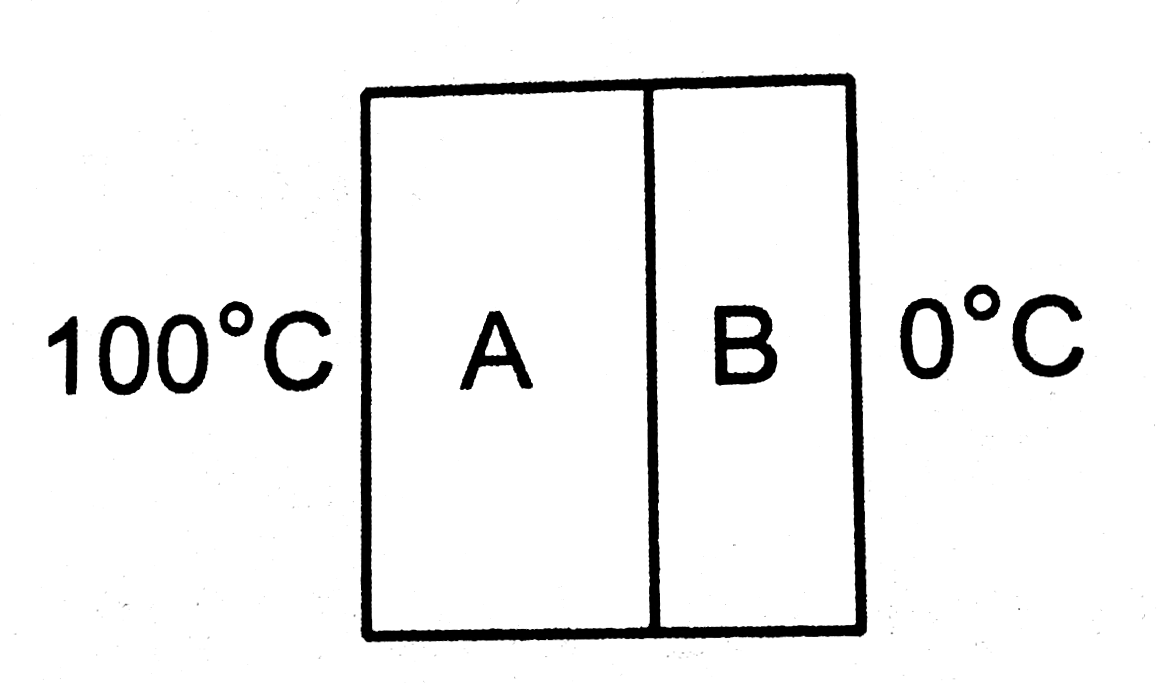Two parallel plates A and B are joined together to form a compound plate . The thicknesses of the plate are 4.0cm and 2.5cm respectively and the area of cross section is 100cm2 for each plate. The thermal conductivities are KA=200Wm−1^(@)C^(-1)forthepa<eB.TheoutersurfaceoftheplateAisma∫a∈≠dat100^(@)CandtheoutersurfaceoftheplateAisma∫a∈edat100^(@)C . and the outer surface of the plate B is maintained at 0^(@)C. Find (a) the rate of heat flow through any cross section, (b) the temperature at the interface and (c) the equivalent thermal conductivity of the compound plate.

Let the temperature of the interface be theta. The area of cross section of each plate is A=100cm2=0.01m2 .The thicknesses are x_(A)=0.004mandx_(B)=0.025m.
The thermal resistance of the plate A is R1=1KAxAA .and that of the plate B is R2=1KBxBA . The equivalent thermal resistance is
R=R_(1)+R_(2)=(x_(A)/K_(A)+x_(B)/(K_(B))).thus,(DeltaQ)/(Deltat)=(theta_(1)-theta_(2))/(R).=(Atheta_(1)-theta_(2))/(x_(A)//K_(A)+x_(B)//K_(B)).((0.01m^(2))((100^(@)C)))/((0.04m)//(200Wm^(-1)^(∘)C−1)+(0.025m)/(400Wm−1^(@)C^(-1))).=3810W.(b)Wehave(DeltaQ)/(Deltat)=(A(theta-theta_(2)))/(x_(B)//K_(B)).or,3810W=((0.01m^(2))(theta-0^(@)C))/((0.025m)(200Wm^(-1)^(∘)C−1)+(0.025m)/(400Wm−1^(@)C^(-1))).or,theta=24^(@)C.(c)IfKisthe≡a≤ntthermalconductivityofthecompoundplate,itsthermalresistanceis<br>R=(1)/(A)(x_(A)+x_(B))/(K).Compar∈gwith(i)(x_(A)+x_(A))/(K)=(x_(A))/(K_(A))+x_(B)/(K_(B)).or,K=(x_(A)+x_(B))/(x_(A)//K_(A)+x_(B)//K_(B)).=248Wm^(-1)^(∘)C−1 .
Topper's Solved these Questions
- HEAT TRANSFERBOOK - HC VERMACHAPTER - HEAT TRANSFEREXERCISE - Short Answer
11 Videos
- HEAT TRANSFERBOOK - HC VERMACHAPTER - HEAT TRANSFEREXERCISE - Objective 1
10 Videos
- HEAT TRANSFERBOOK - HC VERMACHAPTER - HEAT TRANSFEREXERCISE - EXERCIESE
1 Videos
- HEAT AND TEMPERATUREBOOK - HC VERMACHAPTER - HEAT AND TEMPERATUREEXERCISE - Exercise
4 Videos
- INTRODUCTION TO PHYSICSBOOK - HC VERMACHAPTER - INTRODUCTION TO PHYSICSEXERCISE - Exercises
19 Videos
Similar Questions
Find the heat flux through a copper plate 5 cm thick, if a temperature difference of 100 K is maintained between its ends.
View SolutionTwo flat metal plates area placed with their surfaces in contact and their outer surfaces are maintained at temperatures of 100∘C and 0∘C respectively. If the thicknes of the plates are 2cm and 1cm and their thermal conductivities are 10calm−1K−1s−1 and 20calm−1K−1s−1 respectively, find the temperature of the surfaces in contact.
View Solution
Knowledge Check
Two plates of same area are placed in contact. Their thickness as well as thermal conductivities are in the ratio 2:3. The outer surface of one plate is maintained at 10∘C and that of the other at 0∘C. What is the temperature at the common surface?
A0∘CB2.5∘CC5∘CD6.5∘CA plate has a length (5±0.1) cm and breadth (2±0.01) cm . Then the area of the plate is
A(10±0.25)cm2B(10±0.01)cm2C(10±0.001)cm2D(10±1)cm2If two metallic plates of equal thickness and thermal conductivities K1 and K2 are put together face to face and a common plate is constructed, then the equivalent thermal conductivity of this plate will be
 AK1K2K1+K2B2K1K2K1+K2C(K21+K22)3/2K1K2D(K21+K22)3/22K1K2
AK1K2K1+K2B2K1K2K1+K2C(K21+K22)3/2K1K2D(K21+K22)3/22K1K2
Two plates of equal areas are placed in contact wih each other. Their thickness are 2.0 cm and 5.0 cm respectively. The temperature of the external surface of the first plate is −20∘C and that of the external surface of the second plate is 20∘C. What will be the temperature of the current surface if the plates (i) are of the same material, (ii) have thermal conductivities in the ratio 2:5.
View SolutionIf two metallic plates of equal thickness and equal length and thermal conductivities K1andK2 are put together face to face a common plate is constructed, then the equivalent thermal conductivity of this plate will be-
View SolutionTwo metal plates of same area and thickness l1 and l2 are arranged in series If the thermal conductivities of the materials of the two plates are K1 and K2 The thermal conductivity of the combination is .
View SolutionTwo identical plates with thermal conductivities K and 3K are joined together to form a single plate of double thickness. The equivalent thermal conductivity of one composite plate so formed for the flow of heat through its thickness is.
View SolutionTwo identical plates of different metals are joined to form a single plate whose thickness is double the thickness of each plate. If the coefficients of conductivity of each plate are 2 and 3 respectively, Then the conductivity of composite plate will be
View Solution
